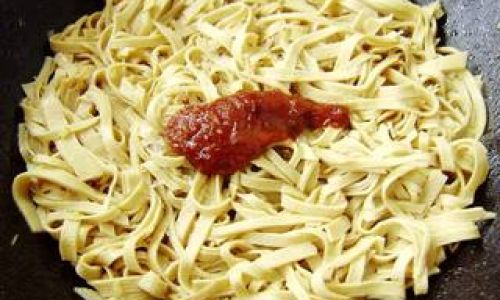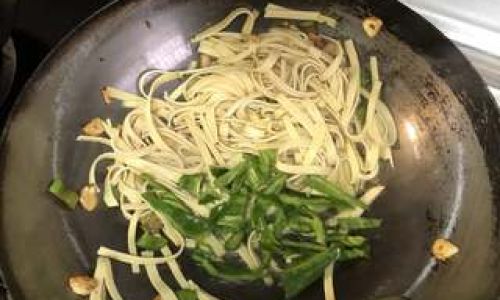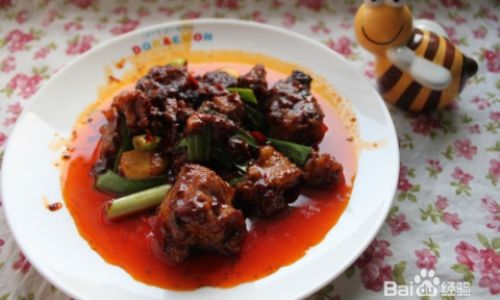Introduction
Stir-fried dried tofu, known in Chinese cuisine as chǎo gān sī (炒干丝), is a dish that marries simplicity with depth of flavor. Originating from China’s Jiangsu Province, this dish has become a beloved staple in home kitchens and restaurants alike, celebrated for its tender texture, aromatic seasonings, and versatility. At its core, chǎo gān sī transforms humble dried tofu sheets into a savory masterpiece, often paired with fresh vegetables, mushrooms, and a medley of spices. This article will guide you through the intricacies of preparing this dish, from selecting the finest ingredients to mastering the stir-fry technique that ensures every shred of tofu is infused with flavor. Whether you’re a novice cook or a seasoned chef, this recipe promises to elevate your understanding of Chinese home-style cooking.

The Essence of Dried Tofu
Dried tofu, or gān sī (干丝), is the star of this dish. Made from thin sheets of soybean curd that have been pressed, dried, and sliced into delicate strands, it offers a unique chewiness and ability to absorb sauces. Unlike fresh tofu, dried tofu has a longer shelf life and a concentrated umami flavor, making it an ideal candidate for stir-fries. When rehydrated and cooked, it becomes tender yet retains a satisfying bite. For optimal results, seek out high-quality dried tofu sheets, often labeled as “tofu skin” or “bean curd sheets” in Asian markets. Avoid varieties that are overly brittle or discolored, as these may indicate age or poor storage.
Ingredients: Building Blocks of Flavor
To create an authentic chǎo gān sī, gather the following ingredients:
- Dried Tofu Sheets (200g): Rehydrate by soaking in warm water for 20 minutes, then slice into thin, even strands.
- Fresh Mushrooms (100g): Shiitake or oyster mushrooms add earthy depth; slice thinly.
- Carrot (1 medium): Julienned for color and crunch.
- Bell Pepper (1/2, preferably red or yellow): Julienned to match the carrot’s shape.
- Garlic (3 cloves): Minced for aromatic punch.
- Ginger (1-inch piece): Finely grated to mellow the dish’s profile.
- Scallions (2 stalks): Separate white and green parts; slice both diagonally.
- Soy Sauce (2 tbsp): Use light soy sauce for salinity, dark soy sauce for color (optional).
- Oyster Sauce (1 tbsp): Enhances umami without overpowering.
- Sesame Oil (1 tsp): For finishing richness.
- Vegetable Oil (2 tbsp): Neutral oil like peanut or canola for stir-frying.
- Stock or Water (1/4 cup): To steam and soften the tofu.
- Cornstarch (1 tsp): Mixed with 2 tbsp water for slurry (optional, for thickening).
- White Pepper (1/4 tsp): Adds a subtle heat.
- Sugar (1/2 tsp): Balances the saltiness.
Optional Additions:
- Dried wood ear mushrooms (rehydrated and sliced) for texture.
- Bamboo shoots or water chestnuts for crunch.
- Chili flakes or Sichuan peppercorns for heat.
- A splash of Shaoxing wine for complexity.
Preparation: The Foundation of Perfect Stir-Fry
-
Rehydrate the Tofu:
Submerge dried tofu sheets in a bowl of warm water. Gently press to submerge fully. After 20 minutes, drain and pat dry with paper towels. Slice into 1/8-inch-thick strands, ensuring uniformity for even cooking.
-
Prep the Vegetables:
Julienne the carrot and bell pepper into matchsticks. Slice mushrooms and scallions. Mince garlic and grate ginger. Set aside each ingredient in separate bowls to streamline cooking. -
Mix the Sauce:
In a small bowl, combine soy sauce, oyster sauce, sugar, white pepper, and 2 tbsp of stock or water. Stir until sugar dissolves. This sauce will form the dish’s flavor base.
Cooking Technique: The Dance of Wok and Flame
Stir-frying is a high-heat, rapid-cooking method that requires precision and timing. Follow these steps to achieve wok hei, the coveted “breath of the wok” that imparts smoky depth:
-
Heat the Wok:
Place your wok or large skillet over high heat. Allow it to smoke slightly—this ensures even heat distribution. Add 2 tbsp of vegetable oil and swirl to coat the surface. -
Aromatics First:
Add minced garlic and grated ginger to the hot oil. Stir-fry for 10–15 seconds until fragrant but not browned. Immediately add the white parts of the scallions, reserving the greens for garnish.
-
Introduce Vegetables:
Toss in the mushrooms, carrots, and bell peppers. Stir-fry vigorously for 2–3 minutes until the vegetables are tender-crisp. The mushrooms will release moisture, creating steam that aids cooking. -
Add Tofu and Sauce:
Gently fold in the dried tofu strands. Pour the prepared sauce over the mixture, using tongs or a spatula to coat evenly. Add remaining stock or water and cover the wok for 1–2 minutes. This allows the tofu to absorb the liquid and soften further. -
Thicken and Finish:
If desired, stir the cornstarch slurry and pour it into the wok. Cook for an additional minute until the sauce thickens. Drizzle with sesame oil and toss to combine. Remove from heat.
Plating and Garnish:
Transfer the stir-fry to a serving platter. Garnish with the reserved scallion greens and a sprinkle of toasted sesame seeds. For a pop of color, add a few fresh cilantro leaves or thinly sliced red chili.
Serving Suggestions
Chǎo gān sī shines as a standalone dish or as part of a multi-course meal. Pair it with steamed jasmine rice, congee, or thin noodles. For a heartier meal, serve alongside grilled meats or crispy pancakes. The dish’s mild flavor profile makes it an excellent canvas for experimentation—try adding shrimp, ground pork, or tofu crumbles for protein.

Troubleshooting Common Pitfalls
-
Soggy Tofu:
Overcrowding the wok traps steam, leading to mushiness. Cook in batches if necessary. Ensure the wok is sufficiently preheated to evaporate moisture quickly. -
Uneven Seasoning:
Toss the ingredients continuously to distribute the sauce evenly. Taste and adjust seasoning before serving, as dried tofu absorbs salt differently than fresh ingredients. -
Burnt Aromatics:
Garlic and ginger burn easily. Add them to the hot oil just before vegetables to prevent bitterness. -
Lack of Wok Hei:
Achieving smoky flavor requires high heat. If using a home stove, preheat the wok until it’s nearly smoking and cook in short, intense bursts.
Variations Across Regions
While the classic Jiangsu-style chǎo gān sī emphasizes subtlety and freshness, regional adaptations abound:
- Sichuan Twist: Add doubanjiang (fermented chili bean paste) and Sichuan peppercorns for a numbing-spicy kick.
- Shanghainese Elegance: Incorporate shredded ham or bamboo shoots, and finish with a drizzle of vinegar.
- Vegetarian Delight: Substitute vegetable stock and omit oyster sauce; use mushroom-based seasonings for umami.
Health Benefits and Nutritional Profile
Dried tofu is a nutritional powerhouse, offering:
- High Protein: A 100g serving provides 50g of plant-based protein, making it ideal for vegetarians and athletes.
- Low Calories: Approximately 300 calories per serving, with minimal fat.
- Rich in Minerals: Calcium, iron, and magnesium support bone health and metabolism.
- Fiber-Rich Vegetables: Carrots and bell peppers add dietary fiber, aiding digestion.
Cultural Significance
Chǎo gān sī transcends its culinary role, embodying Chinese philosophies of balance and harmony. The dish’s minimalist preparation reflects Daoist principles of simplicity, while its layered flavors mirror the complexity of Confucian feasts. In Jiangsu, it is often served during festive occasions, symbolizing prosperity and longevity due to the tofu’s white hue and delicate strands resembling silk—a nod to the region’s historical silk trade.
Conclusion: The Joy of Mastering a Classic
Chǎo gān sī is more than a recipe—it’s a gateway to understanding the nuances of Chinese home cooking. By honoring tradition while embracing creativity, you can adapt this dish to suit your palate and pantry. Whether you prefer it fiery, mild, or vegetarian, the key lies in balancing textures and flavors, ensuring each bite sings with umami. So, gather your ingredients, ignite your wok, and embark on a culinary journey that bridges centuries of tradition with the joy of modern cooking. As you savor your first spoonful, remember that in the art of chǎo gān sī, simplicity is the ultimate sophistication.





0 comments